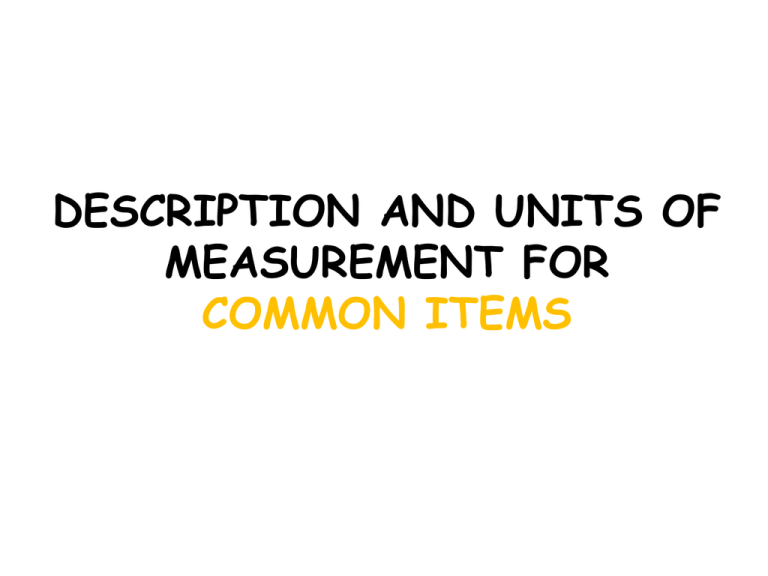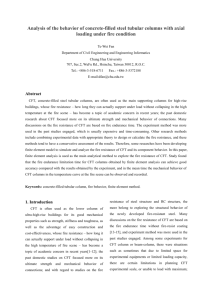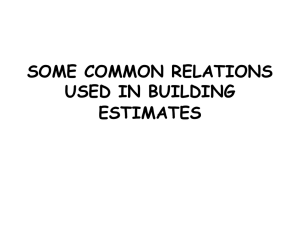description and units of measurement for common items
advertisement

DESCRIPTION AND UNITS OF MEASUREMENT FOR COMMON ITEMS 1 = SITE CLEARANCE WORKS • This item is described in detail but the price of this item is usually indicated as lump sum (LS). • The cost of this item is provided in the estimate by judgment, according to the description of the item and is indicated as Lump sum (L.S). 2 = EXCAVATION FOR FOUNDATION TRENCHES • Earthwork in excavation for foundation trenches is calculated by taking the dimensions of each trench as length X breadth X depth. • It is measured in cubic ft, cubic yard or cubic meter, according to the prevailing practice. • The payment for this item is generally done as Rs. per hundred cubic ft. FILLING IN TRENCHES Filling in trenches after the construction of foundation masonry is ordinary neglected. If the trench filling is, also taken in account, it may be calculated by deducing the volume of masonry in trenches from that of the volume of excavation. 3 = FOUNDATION CONCRETE (P.C.C.) • The type of concrete must be clearly mentioned. The mix proportions and the type of cement, sand and coarse aggregate must be specified. • This item is measured in cubic ft and the unit for measurement is, generally Rs. per 100 cubic ft. • When the soil is soft or weak, one layer of dry bricks or stone soling is applied below the foundation concrete. The soling layer is computed in sq.ft (length X breadth), specifying the thickness in description of item. 4 = BRICKWORK IN FOUNDATION UP TO PLINTH • Care must be taken, while taking dimensions from the drawings in the bill of quantities because the walls in this part of the structure are in the form of steps with changing dimensions. • This item is calculated in cft and the unit for payment is Rs. per 100 cft. • In the description of work, the quality of bricks and mortar ratio must be specified. For example, "Brickwork in foundation and plinth using first class bricks laid in (1:4) or (1:6) cement-sand (c/s) mortar———————“ 5 = BRICKWORK IN SUPER STRUCTURE Important considerations are: a = Measurements of walls shall be taken in the same order and in the same manner as for brickwork in foundations and plinth. b = In the first measurements, all openings such as doors, windows, veranda openings etc. shall be neglected. However, deductions shall be made for all openings in the walls, at the end of the item. BRICKWORK IN SUPER STRUCTURE (ctd) c = In the description of the work, the quality of bricks and mortar ratio have to be specified. d = Masonry for arches shall be paid separately, at a different rate. e = The height of super structure is very important. Generally the quantities are worked out for each storey separately and rates would be different for different storeis because of additional labor work, scaffolding and shuttering. f = The item is worked out in cft and the standard unit for payment is Rs. Per 100 cft. 6 = DAMP PROOF COURSE (D.P.C.) • Horizontal D.P.C. shall extend the full width of the super structure walls, however, it shall not be provided across doorways and veranda openings. It is also provided in roof and floors. • Vertical D.P.C. is provided in external walls, especially, in the walls of basements. • The quantity of D.P.C. is estimated in square ft.(on area basis) and standard unit for payment is Rs. per 100 sft. 7 = ROOFING & RCC WORKS • Area of the Roof slab is calculated by taking inside dimensions of the room plus a bearing of the roof slab on the walls, on all sides. • For R.C.C. Roof slabs and beams, the total quantities of concrete and steel are estimated, separately. • The quantity of plain concrete is estimated in cft and the standard unit for payment of concrete is Rs. per 100 cft. • Volume of Reinforcing Steel is not deducted , while estimating the volume of plain concrete for payment. • c = R.C.C. lintels over wall openings such as doors and windows are also included in R.C.C. work. ROOFING & RCC WORKS (ctd) • Roof consisting of beams, battens, and tiles or wooden planks is estimated for each part, separately. Steel beam is estimated by weight, whereas, wooden beam is measured in cft. Battens are estimated by numbers indicating there size and lengths. Tiles are also estimated by size and numbers. • Roof finishing may consist of bitumen coating and/or Polythene sheets (water proofing) , earth filling (heat proofing) and brick tiles, etc. Dimensions are taken from inner face to inner face of parapet walls. This item is estimated in sft and a composite rate for payment is taken as Rs. per 100 sft of the roof area. 8 = REINFORCEMENT STEEL / GENERAL STEEL WORK • Steel is provided separately from R.C.C. per ton, per Kg, or per cwt (standard weight also called Quintal or century weight equal to 112 Ibs = 50Kg). • Quantity of steel can either be worked out by rules of thumb practice or by intensive calculations taking the length and diameter of steel bars from the working drawings showing reinforcement details and bar-bending schedules. In taking length of bars, due margin of hooks, bends and overlapping is given REINFORCEMENT STEEL / GENERAL STEEL WORK (ctd-) • As a Rule Of Thumb Practice, for ordinary beams and slabs for residences, assume 6.75 Ibs of steel per cft of R.C.C. work. However, for R.C.C. columns, it varies from 8 to 10 Ibs per cft., because normally, we use 2% of steel in columns. • Percentage of steel means, area of steel divided by total area of the column multiplied by 100 and 1% of steel in columns corresponds to a quantity of 4.5 Ibs/cft. 9 = FLOORS • Cement concrete floors. Mosaic floors, and brick floors are most commonly used. • Payments are made separately for different layers, like, topping, lean concrete, sand filling, earth filling, etc. • Earth filling, sand filling and lean concrete are paid by volume, whereas, topping is paid on area basis, mentioning thickness in the description. • Standard unit for payment of topping is, usually, Rs. per 100 sft. • The skirting is estimated in running ft. 10 = PLASTERING • The type of plaster, proportioning of materials and minimum thickness of plaster have to be specified. • The quantity is calculated for total wall surface without deduction for openings such as doors windows, ventilators, etc. However, if the wall is being plastered on both the faces, the deductions for opening areas are made from one side only. • Standard unit for payment is Rs. per 100 sft. • Height is also specified for plastering because, for greater heights, labor cost increases. The rate varies according to the number of the storey 11 = WOODWORK/CARPENTRY • The type of material used and the quantity of finish required should be clearly indicated in the description of the item. • The rate for any type of woodwork includes cutting of timber to required sizes, joinery work, fittings and fastenings, three coats of oil paints or varnish, bolts, locks, handles, etc. • The measurements are taken for the overall area of doors, windows, etc. If volume of timber required for these items is to be finding out, the computed area is multiplied with the nominal thickness and an allowance of 25% is made for wastage of timber. WOODWORK/CARPENTRY (-ctd-) • Rectangular wooden beams, vertical columns, trusses, etc., are measured in cft. • Wooden stairs are measured in number of steps and description of the item includes the riser, tread, and width of the steps. • Wooden shelves are measured in running ft (RFT). 12 = PLUMBING WORK/SANITARY FITTINGS • For water supply and drainage works in a building, the pipe lines and sewer lines are measured in RFT, while other items are measured in numbers. • These items include wash hand basins (W.H.B.), kitchen basins (which may be of glazed ceramic, mosaic, or stainless steel), water closets (W.C., which may be of European type, or local type), flushing tanks (also known as flushing cisterns), shower rose, and all type of water tapes. PLUMBING WORK/SANITARY FITTINGS (-ctd-) • Within sewer lines, man holes or inspection chambers are to be provided at every corner and also at a distance, not exceeding every 50 ft inside the house and every 100 ft outside the house. • The size of man hole may be 2.5ft X 2,5ft for low depths and 3ft X 3ft, 4ft X 4ft or 5ft X 5ft for deep depths. • Drainage pipe lines outside the covered area but inside the boundary wall are, usually, of R.C.C. with minimum diameter 4 in, however, these are available in different sizes. • Inside the building, drainage pipe is, usually, of C.I. with minimum diameter 3 in. • Water supply pipes are, usually, G.I. pipes., estimated in RFT in different dias. • Other accessories, like sockets, elbows, tees, reducers, unions, etc., are estimated in numbers. 13 = ELECTRIC FITTINGS • All the accessories used in electric fittings are described in detail and payment is done in numbers or RFT. • All wires and pipes are taken in RFT while other items are taken in No’s.









